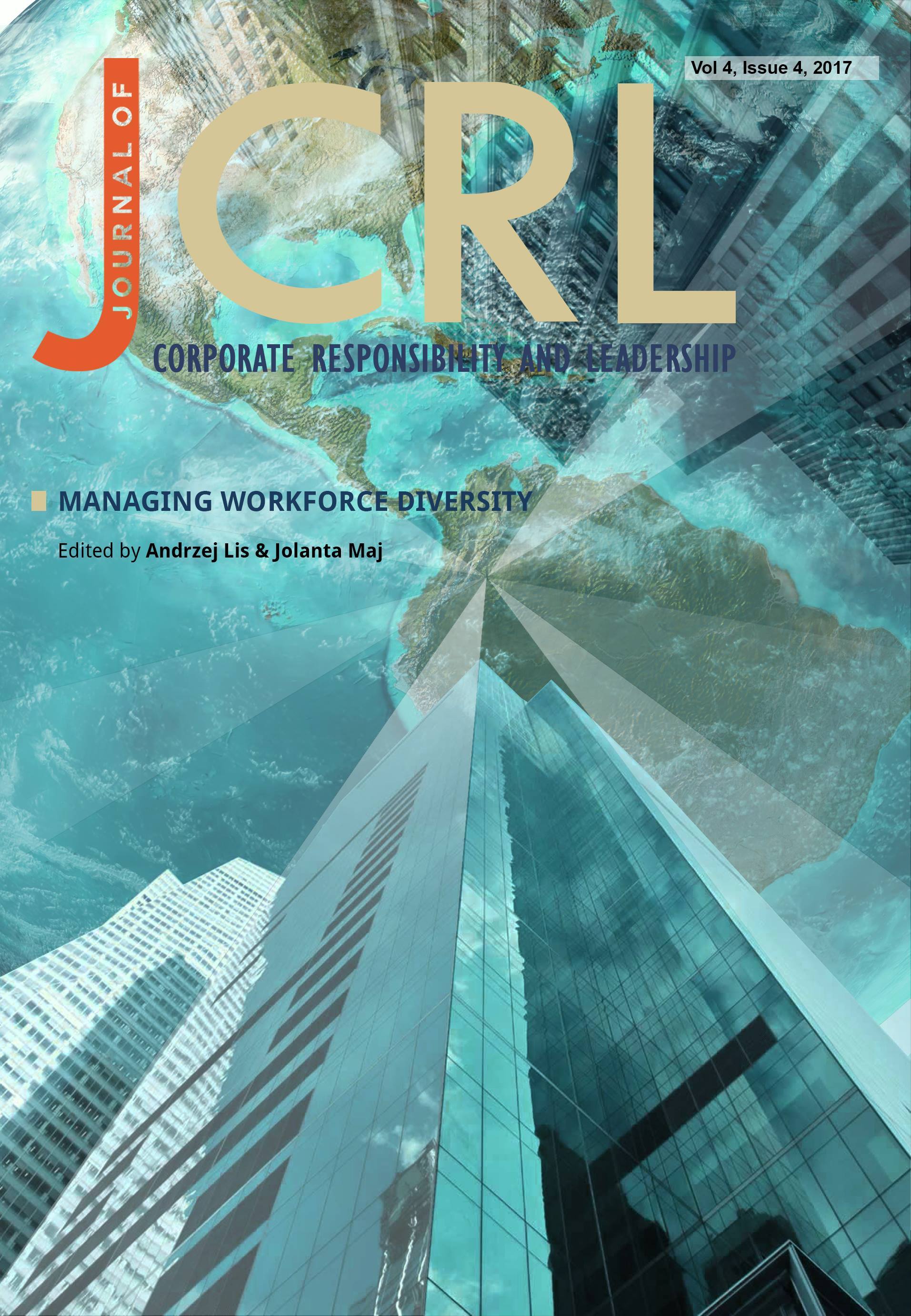Diversity Management as a Base of a Business Model
DOI:
https://doi.org/10.12775/JCRL.2017.026Keywords
business fundamentals, competitiveness, diversity, equality, human resourcesAbstract
Purpose: A crucial element of any business is seeking competitive advantage by distinguishing itself from other market players. One way to reach this advantage is to choose conception of human resources based on the diversity principle. The purpose of this paper is to establish the characteristics of a business model based on diversity management.
Design/methodology/approach: The aim of this article was reached by an analysis of literature on human resources manage-ment, organisational diversity management and business model-ling. The text includes assessments of business models concepts, and conclusions on advantages and disadvantages of a diversity management-based model. The article is theoretical in nature.
Findings: In the article it was emphasized that the main rationale for implementing diversity in market activity is to create a support for creativity, innovativeness and, as a result, better efficiency. So, the company generates profits through greater creativity. Apart from the economic results, social outcomes – such as greater job satisfaction and empathy – may be expected.
Research and practical limitations/implications: The theoretical framework of this text may be the basis for further practical com-parisons and studies on diversity management.
Originality/value: This article summarizes arguments behind the implementation of diversity in business models.
Paper type: theoretical study.
References
Bellman, R., Clark, Ch.E., Malcolm, D.G., Craft, C.J., Ricciardi, F.M. (2009), “On the Construction of a Multi-Stage, Multi-Person Business Game”, Operations Research, Vol. 5, No. 4, pp. 469 – 503.
Bis, J. (2013), “Innowacyjny model biznesowy – sposób na zwiększenie przewagi konkurencyjnej”, in: Kożuch, B. (Ed.), Modele biznesowe, Wydawnictwo Społec-znej Akademii Nauk w Łodzi, Łódź, pp. 53 – 63.
Czermiński, A., Grzybowski, M., Ficoń, K. (1999), Podstawy organizacji i zarządzania, Wyższa Szkoła Administracji i Biznesu w Gdyni, Gdynia.
Duczkowska-Piasecka, M., Poniatowska-Jaksch, M., Duczkowska-Małysz, K. (2013), Model biznesu: Nowe myślenie strategiczne, Difin, Warszawa.
EU (nd), Europa bez granic: Strefa Schengen. Retrieved from: https://ec.europa.eu/ home-affairs/sites/homeaffairs/files/e- library/docs/schengen_brochure/schengen_ brochure_dr3111126_pl.pdf (accessed 28 September 2017).
Ewijk van, A.R. (2011), “Diversity and Diversity Policy: Diving into Fundamental Differences”, Journal of Organizational Change Management, Vol. 24, Issue 5, pp. 680 – 694.
Fombrun, J., Tichy, N.M., Devanna M.A. (1984), Strategic Human Resource Management, Wiley, New Jersey.
Griffin, R.W. (1998), Podstawy zarządzania organizacjami, PWN, Warszawa.
Holladay, C.L., Day, J., Anderson, D.J., Welsh-Skiffington, L. (2010), “A Strategy
for Implementing Diversity Management: A Model Evaluating Need and Effec-tiveness”, International Journal of Diversity in Organisations, Communities & Nations, Vol. 9, Issue 6, pp. 1 – 20.
Investopedia (nd), “Business Model”. Retrieved from: http://www.investopedia.com/ terms/b/businessmodel. asp#ixzz4syV89mKt (accessed 28 September 2017).
Jamka, B. (2011), Czynnik ludzki we współczesnym przedsiębiorstwie: Zasób czy kapitał?, Wolters Kluwer, Warszawa.
Johnson, M.W., Christensen, C.M., Kagermann, H. (2008), “Reinventing Your Business Model”, Harvard Business Review, December, pp. 50 – 59.
Karaszewski, R., Lis, A. (2014), “Is Leadership an Antecedent of Corporate Social Responsibility?: The Study in the Context of Positive Organisational Potential”, Journal of Corporate Responsibility and Leadership, Vol. 1, Issue 1, pp. 53–70.
Kidder, D.L., Lankau, M.J., Chrobot-Mason, D, Mollica, K.A., Friedman, R.A. (2004), “Backlash Toward Diversity Initiatives: Examining the Impact of Diversity Pro-gram Justification, Personal and Group Outcomes”, International Journal of Conflict Management, Vol. 15, Issue 1, pp. 77 – 102.
Kossek, E.E., Lobel, S.A., Brown, J. (2006), “Human Resource Strategies to Manage Workforce Diversity”, in: Konrad, A.M., Prasad, P., Pringle, J.M. (Eds.), Handbook of Workplace Diversity, Sage, London, pp. 53 – 74.
Kubica, I., (2014), “Biznesowy model wdrażania zarządzania różnorodnością”, Prace Naukowe Uniwersytetu Ekonomicznego we Wrocławiu, No. 349, pp. 197 – 206.
Lauring, J., Selmer, J. (2013), “Does Staff Diversity Imply Openness to Diversity?”, International Journal of Educational Management, Vol. 27, Issue 6, pp. 631 – 646.
Lecocq, X., Demil, B., Ventura, J. (2010), “Business Models as a Research Program in Strategic Management: An Appraisal Based on Lakatos”, M@n@gement, Vol. 13, No. 4, pp. 214 – 225.
Menascé, D.A., Almeida, V.A. (2000), Scaling for E-business: Technologies, Models, Performance, and Capacity Planning, Prentice Hall Professional, New York.
Merriam-Webster (nd), “Diversity”. Retrieved from: https://www.merriam-webster.com/dictionary/diversity (accessed 07 November 2017).
Natale, S.M., Fenton, M.B. (1997), Business Education and Training: Instilling Values in the Educational Process, University Press of America.
Ovans, A. (2015), “What is a Business Model?”, Harvard Business Review, January. Retrieved from: https://hbr.org/2015/01/what-is-a-business-model (accessed 28 September 2017).
Rakowska, A. (2014), “Różnorodność zasobów ludzkich – stan badań i wyzwania”, Prace Naukowe Uniwersytetu Ekonomicznego we Wrocławiu, No. 349, pp. 351 – 360.
Roberson, Q.M., Stevens, CK. (2006), “Making Sense of Diversity in the Workplace: Organizational Justice and Language Abstraction in Employees’ Accounts of Diversity-related Incidents”, Journal of Applied Psychology, Vol. 91, No. 2, pp. 379 – 91.
Sudoł, S. (2007), Nauki o zarządzaniu: Węzłowe problemy i kontrowersje, Dom Organizatora TNOiK, Toruń.
Teece, D. (2010), “Business Models, Business Strategy and Innovation”, Long Range Planning, Vol. 43, No. 2/3, pp. 172 – 194.
Wawer, M., (2014), “Kształcenie pracowników w realizacji koncepcji zarządzania różnorodnością”, Prace Naukowe Uniwersytetu Ekonomicznego we Wrocławiu, No 354, pp. 178 – 187.
Wziątek-Staśko, A., (2012), Diversity management: Narzędzie skutecznego motywowania pracowników, Difin, Warszawa.
Downloads
Published
How to Cite
Issue
Section
Stats
Number of views and downloads: 754
Number of citations: 0



